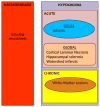Vascular dementia
- PMID: 22575403
- PMCID: PMC3435447
- DOI: 10.1016/j.jns.2012.03.027
Vascular dementia
Abstract
The epidemic growth of dementia causes great concern for the society. It is customary to consider Alzheimer's disease (AD) as the most common cause of dementia, followed by vascular dementia (VaD). This dichotomous view of a neurodegenerative disease as opposed to brain damage caused by extrinsic factors led to separate lines of research in these two entities. Indeed, accumulated data suggest that the two disorders have additive effects and probably interact; however it is still unknown to what degree. Furthermore, epidemiological studies have shown "vascular" risk factors to be associated with AD. Therefore, a clear distinction between AD and VaD cannot be made in most cases, and is furthermore unhelpful. In the absence of efficacious treatment for the neurodegenerative process, special attention must be given to the vascular component, even in patients with presumed mixed pathology. Symptomatic treatment of VaD and AD is similar, although the former is less effective. For prevention of dementia it is important to treat all factors aggressively, even in stroke survivors who do not show evidence of cognitive decline. In this review, we will give a clinical and pathological picture of the processes leading to VaD and discuss its interaction with AD.
Copyright © 2012 Elsevier B.V. All rights reserved.
Figures


References
-
- Wimo A, Winblad B, Jonsson L. The worldwide societal costs of dementia: Estimates for 2009. Alzheimers Dement. 2010;6:98–103. - PubMed
Publication types
MeSH terms
Grants and funding
LinkOut - more resources
Full Text Sources
Medical

